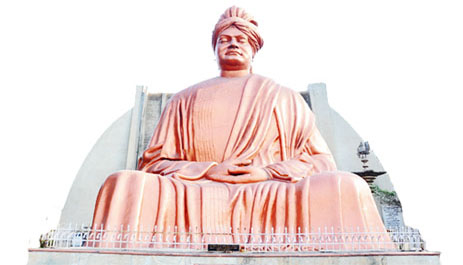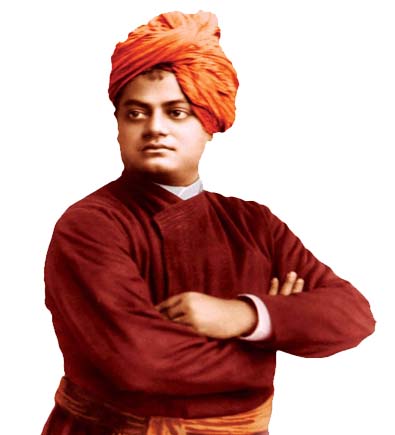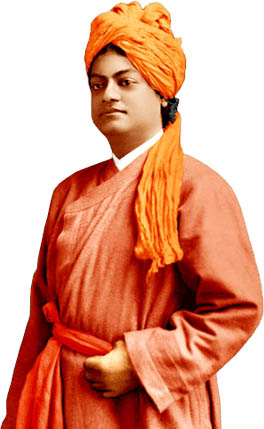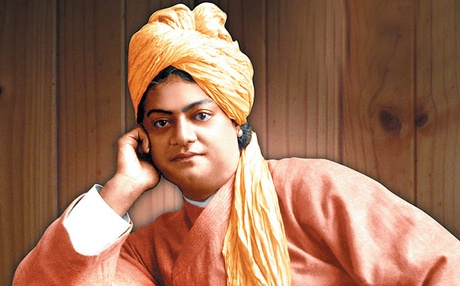Swami Vivekananda
Swami Vivekananda was born on January 12th, 1863. This day is celebrated all over India as 'National Youth Day' in remembrance of the dynamic message of Swamiji to the youth of India. Born in a well-to-do family, he was well-schooled in the best schools of his day. His sharp intellect coupled with his prodigious memory stood him in good stead throughout his life. An excellent athlete, Narendranath Dutta, as he was called,was a born leader and commanded respect of his peers, right from his childhood. His melodious voice was soul-entralling and would often immerse Sri Ramakrishna in Samadhi.
Naren, as he was fondly known amongst his relatives and friends, grew up to be an idealistic teenager with profound leadership skills and a broad-minded, liberal heart. His schooling in Western Philosophy seemed to alienate his roots in Indian spirituality and these ideological differences created a fierce tug-of-war in his mind. During the same time, Brahmo Samaj, the organization founded by Raja Ram Mohan Roy, was then firing up the youth of Bengal under the leadership of Keshab Chandra Sen and Devendranath Tagore. Rejecting and questioning the roots of the modes of devotional worship and existing social conditions of then Bengal, the Brahmo Samaj was weaning many youth from all walks of life. Naren, like the rest of the youth, easily fit into the revolutionary ideas of the Brahmo Samaj. He temporarily found some satisfaction on the intellectual levels that this new-found association was based on. But his drive to find God and actually know whether God could be intimately known soon found him knocking at the doors of renowned Bengal leaders. None could satisfy him and some one suggested him to visit the sage of Dakshineshwar, Sri Ramakrishna Paramhamsa.
Naren met Sri Ramakrishna at Dakshineshwar and the famous incidents regarding these meetings, a conversation between the new and old schools, has been described in many books. Despite his initial reservations, Naren found himself visiting the Saint, despite himself. A deep bond of love which surpassed all relationships was established between the Guru and the disciple. Sri Ramakrishna could fathom the potential of the young man and slowly, but surely, he led Naren on the steep and difficult paths of Sadhana. Under Sri Ramakrishna, Naren's budding spirituality blossomed into a wonderful bloom and he soon became established in the heights of Advaita Vedanta -Nirvikalpa Samadhi.
Many youth began visiting Sri Ramakrishna at Dakshineshwar. Some were inspired by reading about Sri Ramakrishna's teachings which were slowly being published by organs of the Brahmo Samaj and other private devotees. Of these youth, some were recognised by Sri Ramakrishna as part of his 'Inner Circle' as he used to say. He assumed the attitude of a Guru and began giving them instructions in spiritual life, encouraging their latent spiritual lives. He banded the bunch of youngsters into a tight group under the leadership of Naren. On his deathbed, Sri Ramakrishna instructed Naren to look after them and he had also instructed them individually and in groups to look up to Naren for inspiration.
Sri Ramakrishna left his mortal body on August 16, 1886, leaving behind a small group of youth who had no place to go. Slowly things looked up and under the leadership of Naren and under the loving motherly eyes of the Holy Mother, Sri Sarada Devi, this group gradually grew in strength. When they were together, the love of Sri Ramakrishna was their common thread and thus was formed the Baranagore Math, the first monastery. This was later shifted to the Alambazar Math. The disciples, stricken with a resolve to realize God, began wandering all over the country as was expected of itinerant monks. Naren himself, who had now assumed monastic vows with the name Swami Vivekananda, also began wandering all over the country.
Wandering from the east, he reached the Himalayas, then went on towards the north, then to Rajputana, Gujarat and wended his way to the South of India. On Christmas Eve, 1892, he was found seated meditating on the southern-most point of India, at Kanya-Kumari. He had wandered all over India, faced all types of people and situations. He had been at the door-steps of the grinding poverty of the poor as well as the lavish royalty of kings. His heart ached for the many poor of the nation, whose lives were being crushed due to poverty and illiteracy. The wide social chasm in Hindu caste society disgusted him and he was deeply anguished to see the pathetic conditions of the poor people. Sitting on the rock, meditating for three days, he arrived at momentous answers to his questions. He knew that religion was the backbone of India and this is what has to be the bed-rock of modern India. By religion, he understood that it meant not the Brahminical customs of the day, but the eternal Vedantic truths found in the ancient scriptures of India, the Vedas. Only by looking up every being as a part of the One, beyond the confines of race, creed, colour or caste, could true character be moulded. And who else, but the hundreds of wandering monks, perennial guests of society, to preach this great Vedantic truths. Thus he recognised the need for an organization of monks who would dedicate their lives to the uplift of society and by doing so with such personal self-sacrifice, would themselves rise to be spiritual giants. But who would listen to him, a simple wandering monk? He had already heard of a great session of world religious leaders who would be participating in the 'World Congress of Religions' to be held in Chicago in faraway USA. Many of the Swami's well-wishers had also urged him on to take part in the same. With the nod of the Holy Mother, Swamiji decided to participate in the same.
Swami Vivekananda represented Hinduism at the Parliament of Religions on September 11th, 1893 and this day could be said to be day when the West was connected to the East. Since Swamiji's time, innumerable spiritual Gurus and organizations have spread all over the US and continue to do so even today. Yoga, Zen, Meditation, Eastern studies, Ayurveda etc. have found sincere and devout following all over the world thanks to this advent of Swamiji. Swamiji, of course, blazed through the US church scene with his brilliant discourses. His talks were crowded and people had to be turned away at times. Swamiji next visited England and other European nations and had talks with renowned intellectuals of that time like Max Mueller and Paul Duessen etc. He arrived in India to a hero's welcome.
If a nation woke up to receive someone, it can be said that India has never before and never after received anyone with the immense sense of gratitude and respect that was accorded to Swami Vivekananda on his return from the West. On his part, Swami Vivekananda delivered a series of lectures, now published as 'Lectures from Colombo to Almora', in which he poured out his ideas to enthusiastic crowds. Youth were roused to the ideas of character-building and social-service. Swamiji's concept of service of the poor considering them as Daridra Narayana, fired a section of youth in Benares and they formed a 'Home of Service' which is even now functioning as the famous Sri Ramakrishna Vivekananda Mission Home of Service (Sevashrama).
The Ramakrishna Mission came into existence in 1897 and Swamiji created the formal rules and regulations of the new organization. A big plot of land was purchased in the village of Belur, on the banks of the Ganga (Hoogly) and on this he planned the construction of a huge temple dedicated to Sri Ramakrishna. He wished that this would be the epicentre of all the activities of the Ramakrishna Math and Mission, from which India shall recover her long-forgotten ideals of renunciation and service. In 1937, under the expertise of the then President, Swami Vijnananandaji, a beautiful temple, drawing inspiration from all the major religions of the world, with a beautiful marble image of Sri Ramakrishna was established. This is the headquarters of the world-wide Ramakrishna Math and Mission.
Swamiji visited the West again for a smaller period and this time concentrated more on instructing smaller groups and laying the foundations for long-lasting centres in the West itself. Swamis Turiyananda, Abhedhananda and many others put aside their personal qualms and took up the yoke of Swami Vivekananda. Today, there are many centres all over the US, Europe and South America.
Swamiji spent the last days of his life in Belur itself, instructing and teaching the inmates of the Math, with ideals that he himself was as the role model. He left his mortal body on July 4, 1902. He was yet to touch his 40th year. On analysing Swamiji's life, his message from September 11, 1893 to his last day, a mere 9 years, has lasted more than a century, firing youth with inspiration and hope.
A beautiful temple dedicated to Swami Vivekananda is at Belur Math. His room, where he stayed for the last few months, has been kept as it was during his time.
Teachings
- My ideal, indeed, can be put into a few words, and that is: to preach unto mankind their divinity, and how to make it manifest in every movement of life.
- Education is the manifestation of perfection already in man.
- We want that education by which character is formed, strength of mind is increased, the intellect is expanded, and by which one can stand on one’s own feet.
- So long as the millions die in hunger and ignorance, I hold every man a traitor who, having been educated at their expense, pays not the least heed to them!
- Whatever you think, that you will be. If you think yourselves weak, weak you will be; if you think yourselves strong, strong you will be.
- Strength is life; weakness is death.
- Arise! Awake! and stop not till the goal is reached.
- The older I grow, the more everything seems to me to lie in manliness. This is my new Gospel.
- Purity, patience, and perseverance are the three essentials to success, and above all, love.
- I only preach what is good for universal humanity.
- Religion is realization; not talk, not doctrine, nor theories, however beautiful they may be. It is being and becoming, not hearing or acknowledging; it is the whole soul becoming changed into what it believes.
स्वामी विवेकानन्द

स्वामी विवेकानन्द का संन्यास से पूर्व का नाम नरेन्द्रनाथ दत्त था । उनका जन्म कोलकाता के एक समृद्ध परिवार में 12 जनवरी 1863 ई. को हुअ था । उनके पिता श्री विश्वनाथ दत्त एक अधिवक्ता थे । उनकी माता का नाम भुवनेश्वरी देवी था । अपने बाल्यकाल में नरेन बलिष्ठ देह, प्रखर बुद्धि एवं योगी– स्वभाव के बालक थे । उन्होंने गणित, इतिहास एवं दर्शन शास्त्र में स्नातक होने के पश्चात विधिशास्त्र का अध्ययन किया । 18 वर्ष की आयु में महाविद्यालय में अध्ययन करते समय वे श्रीरामकृष्ण से मिले ।
अपने गुरु के प्रेमपूर्ण मार्गदर्शन में वे अध्यात्म राज्य के गूढ़ तत्त्वों से अवगत हुए । श्री रामकृष्ण की महासमाधि के उपरान्त स्वामी विवेकानन्द के नेतृत्व में उनके चौदह युवा शिष्यों ने संन्यिसयों का एक संघ बनाया (दो शिष्य बाद में आये), जिसे रामकृष्ण मठ (संघ) के नाम से जाना गया । (उन सोलह संन्यासी शिष्यों के नाम हैं – विवेकानन्द, ब्रह्मानन्द, योगानन्द, प्रेमानन्द, निरंजनानन्द, शिवानन्द, सारदानन्द, रामकृष्णानन्द, अभेदानन्द, अद्भुतानन्द, तुरीयानन्द, अव्दैतानन्द, त्रिगुणातीतानन्द, सुबोधानन्द, अखण्डानन्द एवं विज्ञानानन्द।) रामकृष्ण संघ का प्रथम मठ कोलकाता के वराहनगर के एक जीर्ण-शीर्ण भवन में आरम्भ हुआ ।

दो वर्षों तक मठ में रहने के पश्चात स्वामी विवेकानन्द ने कुछ वर्ष एक परिव्राजक संन्यासी के रूप में सम्पूर्ण भारत का भ्रमण किया । इन यात्राओं में असंख्य दीन-हीन भारतीयों की भयानक दरिद्रता एवं पिछड़ेपन को देखकर वे अत्यन्त दुःखी हुए, किन्तु साथ ही उन्होंने यह भी देखा कि दरिद्रता के उपरान्त भी लोगों में धर्म के प्रति प्रेम और आस्था है तथा उनके जीवन में प्राचीन आध्यात्मिक संस्कृति प्राणदायी शक्ति के रूप में विद्यमान है । जिस समय समाज सुधारक विधवा-विवाह तथा मूर्ति-पूजा उन्मूलन में व्यस्त थे, उस समय स्वामी विवेकानन्द ने यह अनुभव कर लिया था कि भारत के लिए धन-धान्य उत्पन्न करने वाले सामान्य जनता के पिछड़ेपन का मूल कारण उनकी उपेक्षा एवं उच्च वर्ग के स्वार्थ के लिए उनका शोषण किया जाना है । उनकी आर्थिक स्थिति सुधारने के लिए यह आवश्यक है कि उन्हें कृषि के उन्नत तरीकों, ग्रामोद्योगों एवं जीवन में स्वच्छता के विषय में सिखाया जाये । परन्तु सदियों के शोषण एवं सामाजिक अत्याचार से निर्धन जनता, विशेषकर जो निम्न जातियों से थे, अपनी योग्यता, आशा एवं स्वतः प्रेरणा की चेतना खो बैठे थे । इसलिए जनता को शक्ति का संदेश देने की आवश्यकता थी, जिससे उनके मन में विश्वास बिठाया जा सके । स्वामी विवेकानन्द ने वेदान्त में यह सन्देश पाया । इसी प्रकार स्वामीजी ने देखा कि जनता को ऊपर उठाने के लिए यह आवश्यक है कि उनमें लौकिक एवं आध्यत्मिक शिक्षा का प्रसार किया जाये । इसके लिए आवश्यकता थी एक ऐसे संगठन की जो सर्वोत्त्म विचारों को सबसे दरिद्र एवं दीन-हीन के द्वार तक पहुँचा सके ।
भारत भ्रमण के समय स्वामी विवेकानन्द ने शिकागो की विश्व धर्म-महासभा के आयोजन की योजना के सम्बन्ध में सुना । उन्होंने अनुभव किया कि अपने गुरु के सन्देशों को विश्व में प्रस्तुत करने के लिए धर्म-महासभा उचित मंच सिद्ध होगा । अतः उन्होंने अमेरिका जाने का निर्णय लिया । स्वामी विवेकानन्द का अमेरिका जाने के लिए प्रेरित होने का दूसरा कारण था – सामान्य लोगों के जीवन-स्तर को ऊपर उठाने की अपनी योजना में आर्थिक सहायता प्राप्त करना । सितम्बर 1893 में शिकागो की विश्व धर्म-महासभा में उनके भाषणों ने उन्हें विश्व-प्रसिद्ध बना दिया । पश्चिम में स्वामी जी ने पाया कि वहाँ के लोगों ने अपनी सामाजिक एवं आर्थिक समस्याओं का बहुत कुछ समाधान कर लिया है, और वे परम सत्य तथा सार्थक जीवन की खोज कर रहे हैं । स्वामीजी विश्वास करते थे कि वेदान्त उनकी उच्च आवश्यकताओं को पूर्ण कर सकता है ।

स्वामी विवेकानन्द पश्चिम में प्रायः साढ़े तीन वर्षों तक वेदान्त का प्रचार-प्रसार करने के बाद जनवरी 1897 में भारत लौटे । सर्वत्र प्राप्त उत्साहपूर्ण स्वागत के उत्तर में स्वामीजी ने भारत के विभिन्न भागों में अनेक व्याख्यान दिये । इन व्याख्यानों के द्वारा स्वामीजी ने निम्न प्रयास किये ।
- लोगों में धार्मिक चेतना का उत्थान तथा उनमें अपनी सांस्कृतिक विरासत के प्रति गौरव उत्पन्न करना ।
- समानता के आधार पर हिन्दुत्व का एकीकरण ।
- पददलित साधारण जनता की दुर्दशा की ओर शिक्षित लोगों का ध्यान केन्द्रित करना तथा व्यावहिरक जीवन में वेदान्त को अपनाकर उनकी उन्नति करने सम्बन्धी अपनी योजना का प्रतिपादन करना ।
स्वामीजी ने 1 मई 1897 को कोलकाता में श्रीरामकृष्ण के शिष्यों एवं भक्तों की एक सभा आयोजित की तथा रामकृष्ण मिशन नामक एक नयी आध्यात्मिक संस्था का शुभारम्भ किया । वे इसे एक ऐसी अव्दितीय संस्था बनाना चाहते थे, जिसमें संन्यासियों एवं गृहस्थ लोगों की सहायता से निर्धनों तथा दीन-दुःखियों को शैक्षिणक, चिकित्सकीय और अन्य प्रकार की सामाजिक सेवा प्रदान की जाय ।
स्वामी विवेकानन्द ने श्रीरामकृष्ण द्वारा आचरित एवं उपदेशित वेदान्त के जीवनदायी सिद्धान्तों की शिक्षा एवं व्यावहरिक प्रयोग के लिए संस्था को गति प्रदान करने के पश्चात 4 जुलाई 1902 ई. को, 39 वर्ष 6 माह की आयु में इस मर्त्य लोक से विदा ली ।

For more information, visit: http://www.belurmath.org/swamivivekananda.htm